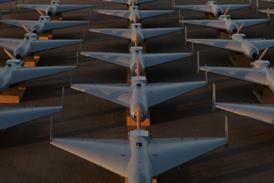The landing approach being shown above is to Tokyo Haneda airport and is being demonstrated on the first Boeing 737-700 full flight simulator produced by the Tulsa, Oklahoma-based Simulation Systems division of FlightSafety International.
About to be shipped to the UK, it will join the Flight- SafetyBoeing fleet of advanced trainers in a location due to be announced imminently.
The simulator is a Level D machine, deemed by regulatory authorities to be sufficiently lifelike that time spent in it counts as flying time.
The pilot is shown using the Flight Dynamics head-up guidance system (HGS), which differs from a head-up display (HUD) by telling the crew not just what is happening currently but actively guiding them to touchdown.
The HGS positions a guidance cue on the runway and the pilot steers the aircraft to superimpose a 'velocity vector' cross on the circle. As long as he keeps the cross within the circle, the system will guide him down to the requisite landing spot.
"HGS is a new device that's going to become more and more prevalent," says Roger Ritchie, FlightSafety's director, communications. As well as appearing on upmarket executive jets, it has been selected as standard equipment by Southwest Airlines.
Source: Flight Daily News























